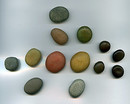Studio by Sculpey Strength Tests
 In my previous Studio by Sculpey review, I linked to a couple of folks who mentioned their Studio by Sculpey projects turned brittle a few weeks after baking. That hadn't been my experience at all, but I was still basing my long-term strength conclusions on the clay packet I got from a preview sample. I decided to run a few tests to see how the new off-the-shelf stuff stacks up.
In my previous Studio by Sculpey review, I linked to a couple of folks who mentioned their Studio by Sculpey projects turned brittle a few weeks after baking. That hadn't been my experience at all, but I was still basing my long-term strength conclusions on the clay packet I got from a preview sample. I decided to run a few tests to see how the new off-the-shelf stuff stacks up.
The Setup
 A month ago, I baked 5 sheets (thicknesses #1-5 on my Atlas pasta machine, where #1 is the thickest) of each of these clays:
A month ago, I baked 5 sheets (thicknesses #1-5 on my Atlas pasta machine, where #1 is the thickest) of each of these clays:
- Premo!
- Studio by Sculpey Sample -- the sample pack I received several months before the official release of the product
- Studio by Sculpey -- the official stuff
Each sheet was 3.5" × 2.5", and I used the same basic turquoise color of each to make sure color differences weren't affecting the results.
The Tests
 The only polymer clay "strength test" I've seen mentioned is folding it repeatedly to see how many folds it takes before it breaks. (Anybody got other suggestions for testing clay's strength, by the way?) I tried the folding thing, but I wanted to try a few other methods too. Since I'm a little on the accident-prone side, I made a list of some of the (many) ways I've broken things in my life and tried those on the clay samples.
The only polymer clay "strength test" I've seen mentioned is folding it repeatedly to see how many folds it takes before it breaks. (Anybody got other suggestions for testing clay's strength, by the way?) I tried the folding thing, but I wanted to try a few other methods too. Since I'm a little on the accident-prone side, I made a list of some of the (many) ways I've broken things in my life and tried those on the clay samples.
Here are the tests:
- Drop clay from 6 feet in the air onto (the hard) kitchen floor
- Toss edge of clay sheet at edge of countertop from about a foot away, allowing it to ricochet off and hit the kitchen floor
- Hit clay with a hammer
- Fold clay back and forth (til edges meet) at least 5 times
- Tear clay
The Results
All of the clay sheets (every brand, every thickness) did just fine on the dropping, ricocheting, and hammering tests. After each of these tests, I'd flex the sheets gently to see if any weaknesses had developed. They were all fine.On the folding test, I was pleasantly surprised with all the results. I hadn't expected to be able to flex the thickest sheets til their edges met, folding back and forth. As long as I went slowly (& allowed it to curve, not bend), the sheets did fine. I had one Premo sample (#2) break during my first folding tests, but I suspect it was my hurrying the process that caused this as much as anything. All the samples were very strong.
After I'd done the initial folding tests, I decided to use the #5 sheets for some more rigorous testing. I folded back & forth at least 10 times, then I put pressure on the fold itself (like folding and creasing a paper sheet). When I did that, the Premo clay snapped. Both of the Studio by Sculpey samples broke as well, but theirs were more of a slow tear than a snap.
For the last test, I pinched the clay between my fingers and tried to rip it apart. I wasn't able to tear any of the #1 thickness sheets. I was able to tear the #2 thickness on both of the Studio by Sculpey sheets (I couldn't do a thing to the #2 Premo sheet). Any thinner than that, I was able to fairly easily tear the clay for any of the brands. For Premo, it was more of a break or snap; for Studio by Sculpey, it was more of a tear.
My Conclusion
I didn't see any difference in the strength of the Studio by Sculpey sample and the off-the-shelf stuff. They both seem equally durable to me. I saw no evidence of it becoming brittle several weeks after baking.I also didn't see a significant difference between the strength of Premo and Studio by Sculpey. There's a difference in the way they break. Premo cracks or snaps, while Studio by Sculpey tears. To me, Premo seems to behave more plastic-like in this, while Studio by Sculpey is more paper-like. But they both seem similarly strong.
I'm sure there are lots more things to test in this -- for example, these were all flat sheets of even thickness. What about sculpted items that have weaker areas? Still, I don't feel like concerns about Studio by Sculpey becoming brittle should keep anyone from giving it a try.
Course, it all comes down to finding the clay that works best for you for the task you're working on. As Craftymule said, if you're happy with your "tried and true favorite clay products," then "stick to what works."
At the same time, you don't want to "stick" with good enough. I spent way longer than I should have settling for the weak & brittle Sculpey III. I got so frustrated when it broke -- but I stuck with it because I'd invested all that money buying all those colors, plus I was unsure about trying something new. Switching to Premo was very worthwhile. Fewer breaks meant less frustration, plus it allowed me to take my work more seriously. (You don't get too attached to something if you're expecting it to break quickly!)
Sometimes it pays to keep an open mind. Experimenting with new products may create whole new worlds for you, giving you options you didn't know you were missing!













